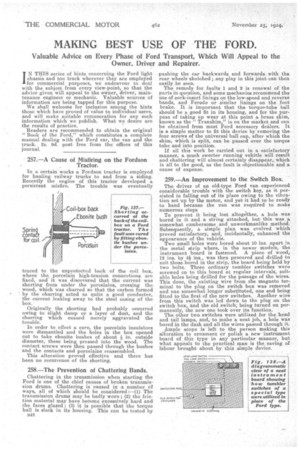MAKING BEST USE OF THE FORD.
Page 32

If you've noticed an error in this article please click here to report it so we can fix it.
Valuable Advice on Every Phase of Ford Transport, Which Will Appeal to the Owner, Driver and Repairer.
/ N THIS series of hints concerning the Ford light chassis and ton truck wherever they are employed for commercial purposes, we endeavour to deal with the subject from every view-point, so that the advice given will appeal to the owner, driver, maintenance engineer or mechanic. Valuable sources of information are being tapped for this purpose.
We shall welcome for inclusion among the hints those which have proved of value to individual users, and will make suitable remuneration for any such information which we publish. What we desire are the results of practice.
Readers are recommended to obtain the original " Book of the Ford," which constitutes a complete manual dealing with the Ford car, the van and the truck. 2s. 9d. past free from the offices of this journal.
• 257.—A Cause of Misfiring on the Fordson Tractor.
In a certain works a Fordson tractor is employed for hauling railway trucks to and from a siding. Recently the engine of this tractor developed a persistent misfire. The trouble was eventually
traced to the unprotected back of the coil box, where the, porcelain high-tension connections are fixed, and it was discovered that the current was shorting from under the porcelains, crossing the wood, which was charred so that the carbon formed by the charring acted as quite a good conductor, the current leaking away to the steel casing of the box.
Originally the shorting had probably occurred owing to slight damp or a layer of dust, and the charring which ensued merely aggravated the trouble.
In order to effect a cure, the porcelain insulators were dismantled and the holes in the box opened out to take ebonite bushes of about in. outside diameter, these being pressed into the wood. The contact screws were then passed through the bushes and the contacts and porcelains reassembled.
This alteration proved effective and there has been no recurrence of the shorting.
258,—The Prevention of Chattering Bands.
Chattering in the transmission when starting the Ford is one of the chief causes of broken transmission drums. Chattering is caused in a number of ways, all of which should be considered :—(1) The transmission drums may be badly worn ; (2) the friction material may have become excessively hard and the faces glazed ; (3) it is possible that the torque ball is slack in its housing. This can be tested by
B48
pushing the car backwards and forwards with the rear .wheels-skotehed; any play in this joint can then easily be seen.
The remedy for faults 1 and 2 is renewal of the parts in question, and some mechanics recommend the use of cork-insert linings on the low-speed and reverse bands, and Ferodo or similar linings on the .foot brake. It is important that the torque-tube hall should be a goad fit in its housing, and for the purpose of taking up wear at this point a brass shim, known as the Transhim," is on the market and can be obtained from most Ford accessory dealers. It is a simple matter to fit this device by removing the, four screws of the universal ball cap, after which the shim, which is split, can be passed over the torque tube and into position.
If all this work be carried out in a satisfactory manner, a much sweeter running vehicle will result and chattering will almost certainly disappear, which is all to the good, as the fault is objectionable and a cause of expense.
259.—An Improvement to the Switch Box.
The driver of an old-type Ford van experienced considerable trouble with the switch key, as it persisted in falling out of its place owing to the vibration set up by the motor, and yet it had to be ready to hand because the van was required to make numerous stops
To prevent it being lost altogAher, a hole was bored in it and a string attached, but this was a,• somewhat cumbersome and unworkmanlike method.Subsequently, a simple plan was evolved which proved satisfactory, and, incidentally, enhanced the appearance of the vehicle. Two small holes were bored about 10 ins, apart in the metal strip where, in the newer models, the instrument board is fastened. A piece of wood; 12 ins, by ai ins., was then procured and drilled to suit those,bored in the strip, the board being held by two bolts. Three ordinary tumbler switches were screwed on to this board at regular intervals, suit. able holes being drilled for the passage of the wires. This done, the existing wire from the magneto terminal to the plug on the switch box was removed and one somewhat longer substituted, one end being fitted to the first of the new switches. Another wire from this switch was led down to the plug on the switch box, and the old switch, being turned on permanently, the new one took over its function.
The other two switches were utilized for the head and tail lamps, and, to make a neat job, a hole was bored in the dash and all the wires passed through it.
Ample scope is left to the person making this alteration to ornament or polish a new instrument board of this type in any particular manner, but what appeals to the practical man is the saving of labour brought about by this simple device.


































